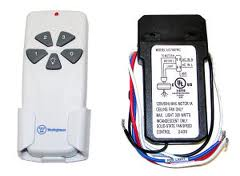 A ceiling fan remote is a great thing to have, even though it causes a lot of confusion. Although it is convenient, people ask if they can, or should use both to control the fan.
A ceiling fan remote is a great thing to have, even though it causes a lot of confusion. Although it is convenient, people ask if they can, or should use both to control the fan.
For the most part, a remote switch is used when there is only one power supply coming into the fan. In other words you don’t have separate switches to independently operate the fan and the light kit. The remote makes this possible. The remote switch is connected inside the ceiling junction box and is controlled with a hand held or wall mounted unit, and allows you to turn the fan and light on-or-off at your will. If you don’t have a remove and don’t have separate switches, you will have to use the pull chains hanging down from the fan.
The confusion comes with using the remote and the pull chain. Don’t use the pull chain if you are using a remote. In many cases, a customer will call saying that the remote doesn’t work anymore and they even replaced the batteries. The problem is usually that someone pulled the chain and turned off the fan. The pull chains usually have graduated speeds: low, medium, high, and off. You want the pull chain to be on it’s maximum setting, and then use the remote. The only problem is when someone pulls the chain which will move the setting from maximum to off…then the remote won’t work.
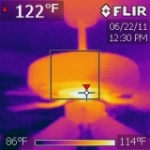 We’ve all heard that that ceiling fans make a room feel cooler in the summertime. For those of us in the desert, in most houses during the summer, ceiling fans are used every day. It’s not that the fan cools the air, but rather makes you feel cooler with the wind chill effect. Did you also realize that a ceiling fan is a 100% efficient heater?
We’ve all heard that that ceiling fans make a room feel cooler in the summertime. For those of us in the desert, in most houses during the summer, ceiling fans are used every day. It’s not that the fan cools the air, but rather makes you feel cooler with the wind chill effect. Did you also realize that a ceiling fan is a 100% efficient heater?
In order to move the fan’s blades an electric motor is used to turn the blades that move the air. This motor has a byproduct: heat. You can see from the picture that ceiling fans can run hot. This heat is created and distributed in the room. How much of a difference does that amount of heat make? I don’t know, but I would guess it is worth continuing to run the fan as it makes the room “feel” cooler by several degrees, and I don’t think the amount of heat produced would be enough to offset that cooling effect.
So what should you do knowing that a ceiling fan creates heat as it operates? I will continue to run my ceiling fan and not worry about it. The ceiling fan does a great job of helping a room’s occupants to feel cooler, even though in reality it creates a small amount of heat in the process.
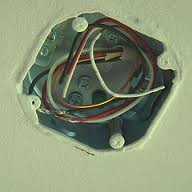 A ceiling fan that wobbles when you turn it on is very frustrating. Most people will simply buy a balancing kit and attempt to balance the fan with small weights. This works great, so long as the ceiling fan has a solid foundation. In this case the foundation is the point where the fan connects to the ceiling.
A ceiling fan that wobbles when you turn it on is very frustrating. Most people will simply buy a balancing kit and attempt to balance the fan with small weights. This works great, so long as the ceiling fan has a solid foundation. In this case the foundation is the point where the fan connects to the ceiling.
A loose junction box may be the culprit. If the box is not properly secured to the ceiling, you will never get the fan to be stable. Also, the box may be plastic and have too much flex in it to support the weight of a fan. If the junction box is metal, you may be able to drive a few screws into it to make it rigid. If that doesn’t work you can try a brace bar.
A brace bar will solve many problems, including a loose junction box. You will need to remove the old junction box first. If it is nailed in, it is easier to run a demolition blade between the box and the joist to cut it free…just make sure you clear the cable out of the way. Once the old box is out, you can slide the brace bar into the hole and run the cable through it.
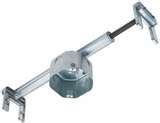 A ceiling fan typically weighs more than your average light fixture. So if you are replacing a light fixture with a ceiling fan, make sure the box in the ceiling is not only able to support the weight of a ceiling fan, but also that it is rock solid and doesn’t move. If the box has any flex in it, the fan will wobble.
A ceiling fan typically weighs more than your average light fixture. So if you are replacing a light fixture with a ceiling fan, make sure the box in the ceiling is not only able to support the weight of a ceiling fan, but also that it is rock solid and doesn’t move. If the box has any flex in it, the fan will wobble.
A good way to avoid a wobbling ceiling fan is to install a brace bar. It makes for a solid foundation. You will need to remove the old box from the ceiling (turn off the power before doing this). It may either unscrew or you may have to run a saw blade between the outside of the box and the ceiling drywall. Be careful here not to damage any wiring.
The brace bar will have some sharp spikes at either end of it. These spikes dig into the ceiling joists to hold it in place. You place one end into the ceiling hole and then the other end and center the bar over the hole. Then turn the bar and it will push the legs outward toward the joists. When you meet resistance, give it an extra turn to seat the spikes.
With the bar centered over the hole in the ceiling, connect the box to the bar. There is a “U” shaped bolt that hangs over the bar for this. The box connects to the “U” bolt and hangs in place. Connect the electrical cable with a clamp and install the ceiling fan as normal.
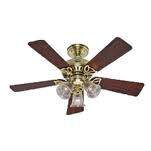 So maybe you are moving, or just want to replace your ceiling fan. You first have to remove it and fortunately this is easy. Probably the most difficult part is getting up on a ladder.
So maybe you are moving, or just want to replace your ceiling fan. You first have to remove it and fortunately this is easy. Probably the most difficult part is getting up on a ladder.
Turn the power off and climb up to the ceiling fan. You will have a choice here in how what steps you take to remove it. Fans can be heavy and those that have a 52" diameter can be a challenge to handle. So , you might choose to remove the blades first before you disconnect the fan. Mark the blades with the corresponding supports where you remove them. This is because the fan can become unbalanced if you move them around, and by marking them you can make sure the same blade goes back onto the same support. Just use masking tape on each piece to mark them.
You will need to get access to the wiring connections. Unscrew the cover at the ceiling. There are two screws that hold this on to the fan. The cover will drop down and you can pull out the wires. You should see the wire nuts inside the hanger. Pull these out and remove the wire nuts and the ceiling fan wires that they connect to. Place a wire nut back onto the ceiling wire and tuck it gently back into the ceiling.
With the wiring disconnected, you can lift the fan out of the support. If you chose to keep the blades on, this can be awkward because the blades will force you to keep your arm extended.
With the fan removed, you can remove the fan support from the ceiling and either install a new fan, or place a cover over the ceiling junction box.
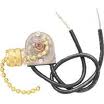 For those of us using a pull-chain to turn the ceiling fan on and off, those pull chain switches can break. They are made of plastic and at some point will need to be replaced. They are inexpensive and shouldn’t take more than an hour of your time.
For those of us using a pull-chain to turn the ceiling fan on and off, those pull chain switches can break. They are made of plastic and at some point will need to be replaced. They are inexpensive and shouldn’t take more than an hour of your time.
You will need to get access to the switch. Turn off the power to the fan, remove the bottom cover of the fan (or remove the light kit, if it has one) and follow the chain up to the switch. The pull chain switch will be secured with two screws to the fan. The switch will have two wires connecting it to the fan’s wiring.
If you fan’s light kit has a harness that connects all the wires, you will likely have to intercept the switch wires. Cut the appropriate wires (follow them from the switch) and use wire nuts to connect the new pull chain switch. Other fans will already use wire nuts.
Once you have the wires connected to the ceiling fan switch, secure the switch to the fan with the screws you removed earlier. The switch will be held to the housing with a decorative nut, once you thread the pull chain through the housing.
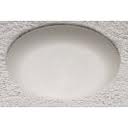 Many people are moving these days, whether by choice or by force. Many of those people choose to take fixtures with them, some of those being ceiling fans.
Many people are moving these days, whether by choice or by force. Many of those people choose to take fixtures with them, some of those being ceiling fans.
If you are going to remove a ceiling fan, do so safely. It is probably best to remove the blades first and then the body of the fan, but many people just remove the body of the fan with the blades still attached. This certainly saves time, but it forces you to wrestle with the fan to remove it. Plus, you have to be careful not to damage any of the blades.
Make sure the power is off and remove the ceiling cover. It will slide down and allow you to access the wiring. The wires should be connected with wire nuts. Unscrew the wire nuts and separate the connected wires. Place a wire nut back onto each wire coming out of the ceiling and screw it on to each wire. The ceiling fan will fit into a bracket that is secured to the junction box in the ceiling. Lift and remove the fan from the bracket and then you can unscrew the bracket from the ceiling.
All you will see now is a hole at your ceiling with some wires sticking out. Gently push the wires into the junction box without kinking or damaging them. Then you can place a ceiling cover over the hole.
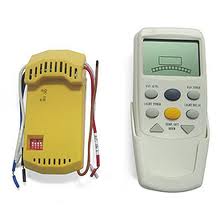 If you have a ceiling fan that operates using a remote, and it no longer operates, there are a few things to check.
If you have a ceiling fan that operates using a remote, and it no longer operates, there are a few things to check.
The very first thing to check would be the power. Make sure that a breaker hasn’t tripped off . Also make sure that someone hasn’t pulled the pull chains at the fan, essentially turning them off. This will happen if someone, who is not aware the fans operate by remote enters the room and assumes the chain will turn the fan on. Then check the battery in the remote. Some remotes are hand-held and some are mounted in the wall. Each style has a door that slides off to allow you access to the battery. The battery will be a 9-volt that just pulls out from the terminals.
If replacing the battery doesn’t work, it’s time to investigate the remote itself. It may be that the remote is broken and needs to be replaced, or that a wire has become disconnected. You will need to get access to the receiver at the top of the fan. Loosen the cover and slide it down. You will see the receiver inside the ceiling fan’s mounting bracket. Check to see if any wires are loose. If they are, reconnect them. Also check the dipswitches at both the receiver and the remote. The dipswitches must have the same positions at both the receiver and remote. It would be unusual if the positions didn’t match, particularly if the ceiling fan was working before, but it may be that someone was tinkering with the remote. You may end up replacing the remote and receiver.
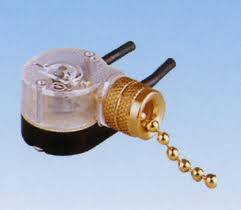 A ceiling fan turns on and off by either a wall switch, remote switch, or pull chain. The pull chain is attached to a switch inside the ceiling fan that will sometimes stop working. The switch is plastic and repetitive pulling or yanking will crack it which necessitates replacement.
A ceiling fan turns on and off by either a wall switch, remote switch, or pull chain. The pull chain is attached to a switch inside the ceiling fan that will sometimes stop working. The switch is plastic and repetitive pulling or yanking will crack it which necessitates replacement.
You can buy a new pull chain switch for just a few dollars and will take under 30 minutes to replace. If you have a light kit on the bottom of the fan you will need to remove it.
Follow the pull chain up into the base of the fan and you will see the switch. The pull chain switch will have two wires at the rear and the chain at the front, and the switch well be held in place with a small retaining nut. There will either be a wiring harness that plugs together, or you may have wires held together with small wire nuts.
If your fan uses wire nuts, it is a matter of replacing the wires of the old switch with the wires of the new one. If you have a harness, you will need to cut the wires that lead to the switch and secure the wires of the new switch to them. It’s a good idea to mark the wires when cutting them. You can use wire nuts to secure the wires together.
Replace the retaining nut to hold the new switch in place and reassemble the fan.
 Removing the wobbling motion of a ceiling fan can be easy or difficult. The easy part is adding weights on the top of the blade or blades that are out of balance. Great. The challenging part is if you have already done that and the fan still is out of balance. There are a couple of things you can do even before adding weights to balance the fan.
Removing the wobbling motion of a ceiling fan can be easy or difficult. The easy part is adding weights on the top of the blade or blades that are out of balance. Great. The challenging part is if you have already done that and the fan still is out of balance. There are a couple of things you can do even before adding weights to balance the fan.
First, check to see that the fan is securely mounted to the junction box in the ceiling and that the junction box is rock solid in the ceiling. Sometimes a homeowner will install a heavy ceiling fan into a junction box that was designed for a light fixture. Well, the ceiling fan is much heavier than the old builder-grade light fixture and consequently it moves. If the box in the ceiling has the slightest bit of movement in it, the ceiling fan will also move. Try installing a brace bar that spans the ceiling joists. These are made for ceiling fans and has a junction box that can be moved along the bar to accommodate the position of the ceiling fan.
Lastly, pick a spot on the ceiling and hold a tape measure up to touch it. Slowly revolve the fan around, one blade at a time, to see where the tip of each blade strikes the tape measure. They should all hit the same spot. If one blade is too high or too low, the fan will wobble. Use rubber washers at the front or rear of the mounting bracket to align the tip of the fan so that all the blades are on the same plane.